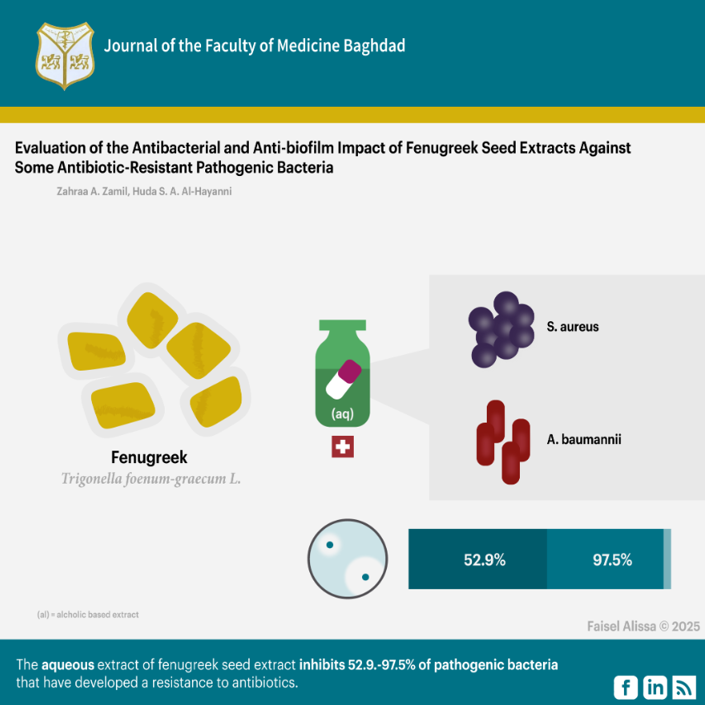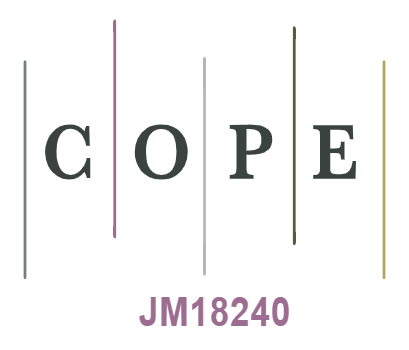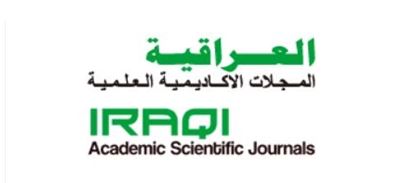Evaluation of the Antibacterial and Anti-biofilm Impact of Fenugreek (Trigonella foenum-graecum L.) Seed Extracts against some Antibiotic-Resistant Pathogenic Bacteria
DOI:
https://doi.org/10.32007/jfacmedbaghdad3139Keywords:
Acinetobacter baumannii, Antibacterial activity, Anti-biofilm impact, Multidrug-resistant bacteria, Staphylococcus aureus, Trigonella foenum-graecum LAbstract
Background: The prevalence of multidrug-resistant bacteria has demonstrated a need to develop and use alternative antimicrobial agents. There has been a growing interest in medicinal plants and herbs and their extracts.
Objective: To identify the antibacterial and anti-biofilm activity of aqueous and alcoholic extracts of the Fenugreek (Trigonella foenum-graecum L.) seed against multidrug-resistant clinical bacterial isolates (Gram-positive Staphylococcus aureus and Gram-negative Acinetobacter baumannii).
Methods: Aqueous and alcoholic extracts were prepared from the seeds of the Fenugreek (Trigonella foenum-graecum L.) plant. A gas chromatography-mass spectrometer was used to identify the active compounds in the extracts. They were tested against multidrug-resistant bacterial isolates that produce biofilms (Gram-positive and Gram-negative), namely Staphylococcus aureus and Acinetobacter baumannii, which were isolated from Iraqi patients in Baghdad Medical City Hospitals (including Burns Specialized Hospital, Baghdad Teaching Hospital, and Al-Shahid Ghazi Al-Hariri Hospital for Surgical Specialties), Al Kadimyia Teaching Hospital, and Al-Kindy Teaching Hospital, from October 2023 to March 2024.
Result: The current study has proved that the aqueous and alcoholic extracts of Fenugreek seeds were effective as antibacterial and anti-biofilm against the studied bacterial isolates, in all the tested concentrations, with significant differences. The study also showed that the aqueous extract of Fenugreek was more effective as an anti-bacterial and anti-biofilm than the alcoholic extract. The aqueous extract demonstrated high inhibitory activity, ranging from 52.9% to 97.5%, while the inhibition of the alcoholic extract varied from 56.0% to 99.5%.
Conclusion: The present study supports the use of fenugreek seed extract to treat pathogenic bacteria that have developed a resistance to antibiotics.
Received: March 2025
Revised: June 2025
Accepted: June 2025
Published Online: June 2025
References
Khalil WL, Al-Hayanni HS. Molecular Detection of the mecA and some Virulence Determinants in Methicillin-Resistant Staphylococcus aureus. J Fac Med Baghdad (Internet). 2024 Jul 1 (cited 2025 Jan 30);66(2):247–53. https://doi.org/10.32007/jfacmedbagdad.6622282
2. Alnuaimi MTH, AL-Hayanni HAS, Al-Janabi ZZ. Green synthesis of gold nanoparticles from Sophora flavescens extract and their antibacterial effect against some pathogenic bacteria. Malays. J. Microbiol., 2023; 19 (1): 74-82.25. Available from http://dx.doi.org/10.21161/mjm.220060
3. Al-Hayanni HSA, El-Shora H. Various extracts of some medicinal plants as inhibitors for beta-lactamase activity. Baghdad Sci J. 2021;18(1):47–53. Available from: https://doi.org/10.21123/bsj.2021.18.1.0047
4. Alaamery SK, Al-Hayanni HSA. The Antibacterial and anti-biofilm effects of Sumac (Rhus coriaria L) fruits extracts against some multidrug-resistant pathogenic bacteria. J Fac Med Baghdad (Internet). 2022 Oct 17 (cited 2025 Jan 30);64(3):183–8. Available from: https://doi.org/10.32007/jfacmedbagdad.6431964
5. Zia-Ul-Haq M, Bin-Jumah MN, Alothman SI & Henidi H. Editors (2021). Alternative Medicine Interventions for COVID-19. https://doi.org/10.1007/978-3-030-67989-7
6. Upton R, David B, Gafner S, Glasl S. Botanical ingredient identification and quality assessment: strengths and limitations of analytical techniques. Phytochem Rev. 2020;19(5):1157–77. Available from: https://doi.org/10.1007/s11101-019-09625-z
7. Qadir A, Khan N, Arif M, Warsi MH, Ullah SNMN, Yusuf M. GC–MS analysis of phytoconstituents present in Trigonella foenum-graecum L. seeds extract and its antioxidant activity. J Indian Chem Soc. 2022;99(6):10050. https://doi.org/10.1016/j.jics.2022.100503
8. Mazumder TZ, Sharma MK, Lal M. Phytochemical properties of some important medicinal plants of north-east India: a brief review. J Pharm Innov. 2022;11(2):167–75. https://www.researchgate.net/institution/North-East-Institute-of-Science-and-Technology?_tp=eyJjb250ZXh0Ijp7ImZpcnN0UGFnZSI6Il9kaXJlY3QiLCJwYWdlIjoicHVibGljYXRpb24ifX0
9. Remya V, Alex MJ, Thomas A. Quality Control of Ayurvedic Medicines. In: Ayurveda in The New Millennium. CRC Press; 2020. p. 71–100. Available from: https://www.researchgate.net/publication/345100135_Quality_Control_of_Ayurvedic_Medicines
10. Di Napoli A, Zucchetti P. A comprehensive review of the benefits of Taraxacum officinale on human health. Bull Natl Res Cent. 2021;45(1):110. https://doi.org/10.1186/s42269-021-00567-1
11. Ceylan Ş, Camadan Y, Saral Ö, & Batur ÖÖ. (2022). Chemical Composition, Antimicrobial, and Antioxidant Activities of Medicinal Plants Nutsedge and Fenugreek. BioResources, 17(3)
.https://doi.org/10.15376/biores.17.3.4580-4594
12. Hadi ST, Mariod AA. Antioxidant and antimicrobial activity of fenugreek (Trigonella foenum-graecum) seed and seed oil. In: Multiple Biological Activities of Unconventional Seed Oils. Elsevier; 2022. p. 111–7. Available from: https://doi.org/10.1016/B978-0-12-824135-6.00011-8
13. Liaqat I, Hussain S, Abid H, Ahmad I, Arif S, ul Haq MA, et al.et al.. An ethnobotanical survey of medicinal plants used for primary health care from Patan Sher Khan and surrounding areas of district Sudhnoti, Azad Jammu and Kashmir, Pakistan. J Appl Res Plant Sci. 2023;4(1):518–28. http://dx.doi.org/10.38211/joarps.2023.04.01.62
14. Holt JG, Krieg NR, Sneath PH, Staley JT, Williams ST. Bergey's Manual of determinate bacteriology. 1994. https://www.sciencedirect.com/science/article/pii/S1319016423001330
15. Pokhrel S, Sharma N, Aryal S, Khadka R, Thapa TB, Pandey P, et al.et al.. Detection of Biofilm Production and Antibiotic Susceptibility Pattern among Clinically Isolated Staphylococcus aureus. J Pathog. 2024;2024:2342468. Available from: https://doi.org/10.1155/2024/2342468
16. Sultana B, Anwar F, Ashraf M. Effect of Extraction Solvent/Technique on the Antioxidant Activity of Selected Medicinal Plant Extracts. Molecules. 2009;14:2167–80. Available from: https://doi.org/10.3390/molecules14062167
17. Yadav UCS & Baquer NZ. (2013). Pharmacological effects of Trigonella foenum-graecum L. in health and disease. Pharmaceutical Biology, 52(2), 243–254. http://dx.doi.org/10.3109/13880209.2013.826247
18. Fonmboh DJ, Abah ER, Fokunang TE, Herve B, Teke GN, Rose NM, et al.et al.. An overview of methods of extraction, isolation and characterization of natural medicinal plant products in improved traditional medicine research. Asian J Res Med Pharm Sci. 2020;9(2):31–57. http://dx.doi.org/10.9734/ajrimps/2020/v9i230152
19. Strompfová V, Štempelová L, Wolaschka T. Antibacterial activity of plant-derived compounds and cream formulations against canine skin bacteria. Vet Res Commun. 2024;48:1459–70. Available from: https://doi.org/10.1007/s11259-024-10324-0
20. Haney EF, Trimble MJ, Hancock REW. Microtiter plate assays to assess antibiofilm activity against bacteria. Nat Protoc. 2021;16(5):2615–32. Available from: https://doi.org/10.1038/s41596-021-00515-3
21. IBM Corp, N. (2017). IBM SPSS statistics for windows. Version 25.0. https://www.ibm.com/products/spss-statistics
22. Khameneh B, Eskin NM, Iranshahy M, Fazly Bazzaz BS. Phytochemicals: a promising weapon in the arsenal against antibiotic-resistant bacteria. Antibiotics. 2021;10(9):1044. https://doi.org/10.3390/antibiotics10091044
23. Behzadi P, Baráth Z, Gajdács M. It’s not easy being green: a narrative review on the microbiology, virulence and therapeutic prospects of multidrug-resistant Pseudomonas aeruginosa. Antibiotics. 2021;10(1):42. https://doi.org/10.3390/antibiotics10010042
24. Alenazy R. Antimicrobial activities and biofilm inhibition properties of Trigonella foenum-graecum methanol extracts against multidrug-resistant Staphylococcus aureus and Escherichia coli. Life. 2023;13(3):703. https://doi.org/10.3390/antibiotics10010042
25. Okoh OS, Yakubu A, Adegboyega AE, Uti DE, Obeten UN, Agada SA, et al.et al.. Identification of some bioactive compounds from Trigonella foenum-graecum as possible inhibitors of PPARϒ for diabetes treatment through molecular docking studies, pharmacophore modelling and ADMET profiling: An in-silico study. PLoS One. 2023;18(5):e0284210. https://doi.org/10.1371/journal.pone.0284210
26. Singh N, Yadav SS, Balasubramanian N. Antimicrobial and Antioxidant Assessment of Trigonella foenum-graecum. Legume Res. 2024;47(7):1113–1119. https://arccjournals.com/journal/legume-research-an-international-journal/LR-5348#:~:text=%7C-,doi,10.18805/LR%2D5348,-Cite%20article%3A%2D
27. Niknam R, Kiani H, Mousavi ZE, Mousavi M. Extraction, detection, and characterization of various chemical components of Trigonella foenum-graecum L. (fenugreek) known as a valuable seed in agriculture. In: Fenugreek: Biology and Applications. Springer; 2021. p. 189–217. Available from: http://dx.doi.org/10.1007/978-981-16-1197-1_9
38. Qadir A, Khan N, Arif M, Warsi MH, Ullah SNMN, Yusuf M. GC–MS analysis of phytoconstituents present in Trigonella foenum-graecum L. seeds extract and its antioxidant activity. J Indian Chem Soc. 2022;99(6):100503. https://doi.org/10.1016/j.jics.2022.100503

Downloads
License
Copyright (c) 2025 zahraa A. Zamil & Huda S. A. AL-Hayanni

This work is licensed under a Creative Commons Attribution 4.0 International License.










 Creative Commons Attribution 4.0 International license..
Creative Commons Attribution 4.0 International license..


